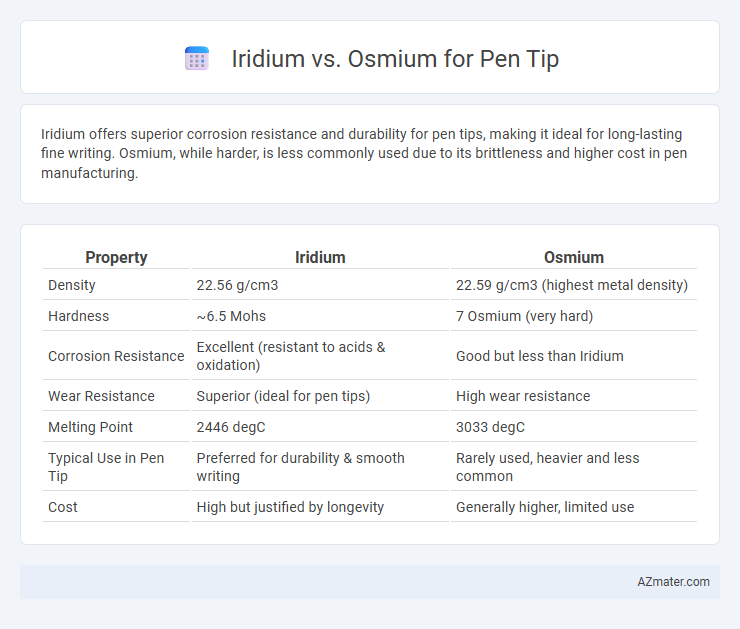Iridium offers superior corrosion resistance and durability for pen tips, making it ideal for long-lasting fine writing. Osmium, while harder, is less commonly used due to its brittleness and higher cost in pen manufacturing.
Table of Comparison
| Property | Iridium | Osmium |
|---|---|---|
| Density | 22.56 g/cm3 | 22.59 g/cm3 (highest metal density) |
| Hardness | ~6.5 Mohs | 7 Osmium (very hard) |
| Corrosion Resistance | Excellent (resistant to acids & oxidation) | Good but less than Iridium |
| Wear Resistance | Superior (ideal for pen tips) | High wear resistance |
| Melting Point | 2446 degC | 3033 degC |
| Typical Use in Pen Tip | Preferred for durability & smooth writing | Rarely used, heavier and less common |
| Cost | High but justified by longevity | Generally higher, limited use |
Introduction to Iridium and Osmium in Pen Tips
Iridium and osmium are both dense, corrosion-resistant metals commonly used for pen tips due to their exceptional hardness and durability. Iridium, a member of the platinum group, offers high resistance to wear and oxidation, making it ideal for smooth, long-lasting writing instruments. Osmium, the densest naturally occurring element, provides extraordinary hardness and a distinctive metallic sheen, but its brittleness limits its widespread use compared to iridium in pen tip manufacturing.
Historical Use of Metals in Pen Nibs
Iridium and osmium have both played significant roles in the historical development of pen nibs, with iridium being favored since the early 19th century for its excellent corrosion resistance and durability under constant ink flow. Osmium, known for its exceptional hardness and resistance to wear, was initially used in the late 19th and early 20th centuries but declined due to its scarcity and brittleness in fine nib tips. The evolution from osmium-tipped nibs to iridium alloys marked a pivotal improvement in writing instruments, balancing longevity and smooth ink delivery in fountain pens.
Physical Properties: Iridium vs Osmium
Iridium and osmium are both among the densest and hardest transition metals, making them ideal for pen tips requiring durability and precision. Iridium exhibits exceptional corrosion resistance and a high melting point of 2,446degC, while osmium has an even higher density at 22.59 g/cm3 but is more brittle and prone to oxidation. The superior hardness and wear resistance of iridium combined with its stability under various conditions often make it the preferred choice over osmium in pen tip manufacturing.
Durability and Wear Resistance Comparison
Iridium and osmium are both valued for their exceptional hardness and wear resistance when used in pen tips, with iridium offering superior corrosion resistance that enhances longevity under frequent use. Osmium, while extremely dense and hard, is more brittle and prone to cracking, which can reduce durability in high-impact writing conditions. The combination of iridium's toughness and resistance to oxidation makes it the preferred choice for pen manufacturers seeking a balance of durability and smooth wear resistance.
Corrosion Resistance in Everyday Use
Osmium pen tips exhibit superior corrosion resistance compared to iridium, making them more durable in everyday use where exposure to moisture and ink acidity is common. Iridium, while hard and wear-resistant, tends to oxidize over time, potentially impacting tip performance and longevity. Osmium's exceptional resistance to corrosion ensures smoother writing experiences and longer-lasting pen tips in various environmental conditions.
Writing Performance: Smoothness and Precision
Iridium pen tips offer exceptional smoothness due to their fine grain structure, providing consistent ink flow and a comfortable writing experience ideal for extended use. Osmium, being the densest naturally occurring element, delivers superior precision and durability, allowing for ultra-fine lines without wear over time. Both metals enhance writing performance, but iridium balances smooth glide with reliability, while osmium excels in maintaining sharp, detailed strokes.
Cost and Rarity Factors
Iridium and osmium are both precious metals used in pen tips, but iridium is more commonly preferred due to its greater availability and lower cost compared to osmium. Osmium is significantly rarer and harder to source, driving its price well above that of iridium, which affects its practicality for widespread use in writing instruments. The durability and corrosion resistance of iridium also make it a cost-effective choice despite osmium's higher density and hardness.
Environmental and Health Considerations
Iridium pen tips, prized for their corrosion resistance and durability, pose minimal environmental hazards due to their inert nature, whereas osmium, especially in its volatile tetroxide form, presents significant health risks from toxicity and environmental contamination. Osmium tetroxide exposure can cause severe respiratory irritation and requires stringent handling protocols to prevent environmental release. Choosing iridium reduces health hazards and environmental impact, making it the safer material for pen tip manufacturing.
Popular Brands and Metal Choices
Popular pen brands like Parker and Montblanc often select iridium for pen tips due to its exceptional hardness and corrosion resistance, ensuring smooth and durable writing experiences. Osmium, while one of the densest and hardest metals, is rarely used in pen nib manufacturing because of its rarity and brittleness compared to iridium. Iridium's balance of durability, smooth ink flow, and resistance to wear makes it the preferred metal choice in high-quality fountain pen tips.
Conclusion: Choosing the Ideal Pen Tip Material
Iridium offers superior corrosion resistance and durability, making it a popular choice for pen tips that require long-lasting performance. Osmium, though harder and denser, is less common due to its brittleness and higher cost, limiting its practicality for everyday writing instruments. Selecting the ideal pen tip material depends on balancing durability, smooth writing experience, and cost-effectiveness, with iridium generally preferred for premium fountain pens.

Infographic: Iridium vs Osmium for Pen Tip
 azmater.com
azmater.com